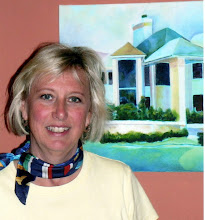A New Way to Be Taught
One of the things I've always appreciated about my teacher, Elmer Ruff, is that he doesn't try to paint my paintings for me, as so many teachers do. And because I teach other subjects, I know how much easier it can be to demonstrate how to do something than it is to get the student to do it herself.
Because Elmer and I have been challenged to find time together, I sent him some images of the painting of the Pendleton Art Center I've been working on. And, as a result, we discovered a great new way to work together!
Elmer is fantastic using computer applications to paint (like Adobe PhotoShop). I, of course, have zero interest in doing that, since I already spend way too many hours in front of a screen. But by painting with my image, he was able to talk to me about things I should improve, demonstrating what he meant with these computer-generated images.
Because Elmer and I have been challenged to find time together, I sent him some images of the painting of the Pendleton Art Center I've been working on. And, as a result, we discovered a great new way to work together!
Elmer is fantastic using computer applications to paint (like Adobe PhotoShop). I, of course, have zero interest in doing that, since I already spend way too many hours in front of a screen. But by painting with my image, he was able to talk to me about things I should improve, demonstrating what he meant with these computer-generated images.
 |
| My teacher's suggestions |
 |
| My work in progress |
I was thrilled with this new way of learning from him: he hasn't touched my actual painting, so I'm still free to do with it what I will. But in the sky in his example, I noticed a nod to the "neo cubist" technique I used to use in past work that I've kind of gotten away from. I think I'd love it here; that it would really improve the work. And while I might resolve the problems differently than Elmer has, I can more clearly understand what he's trying to tell me about the perspective at the top (roof line) of the building, the vagueness of the form in the lower right corner and right edge and how to make the foreground and the "face" of the building more interesting -- front door, loading dock, driveway, trees, etc. Making the subject appear more real using value variations. All while preserving my own style of painting.
There's an old adage "Those who can't do, teach." Nothing could be further from the truth in my opinion. I love teaching but I don't ever want to teach art because it is so much harder to help others learn to develop themselves than to demonstrate your skill. Today, I just want to paint and learn from other artists.
I couldn't be more grateful for the opportunity I've had to learn from Elmer these last nine years -- he has a gift for communicating with me about my work: both what's good about it and how I can continue to improve. Even watching another artist's techniques can be helpful ... C. F. Payne shared some of his techniques with us at the Evendale Art Center a few years ago and I was able to adapt what he did into my own work in a way I still use and feel good about. Every new work is an opportunity to learn and grow.
 |
| I applied techniques learned from C.F. Payne to this home portrait. |


<< Home